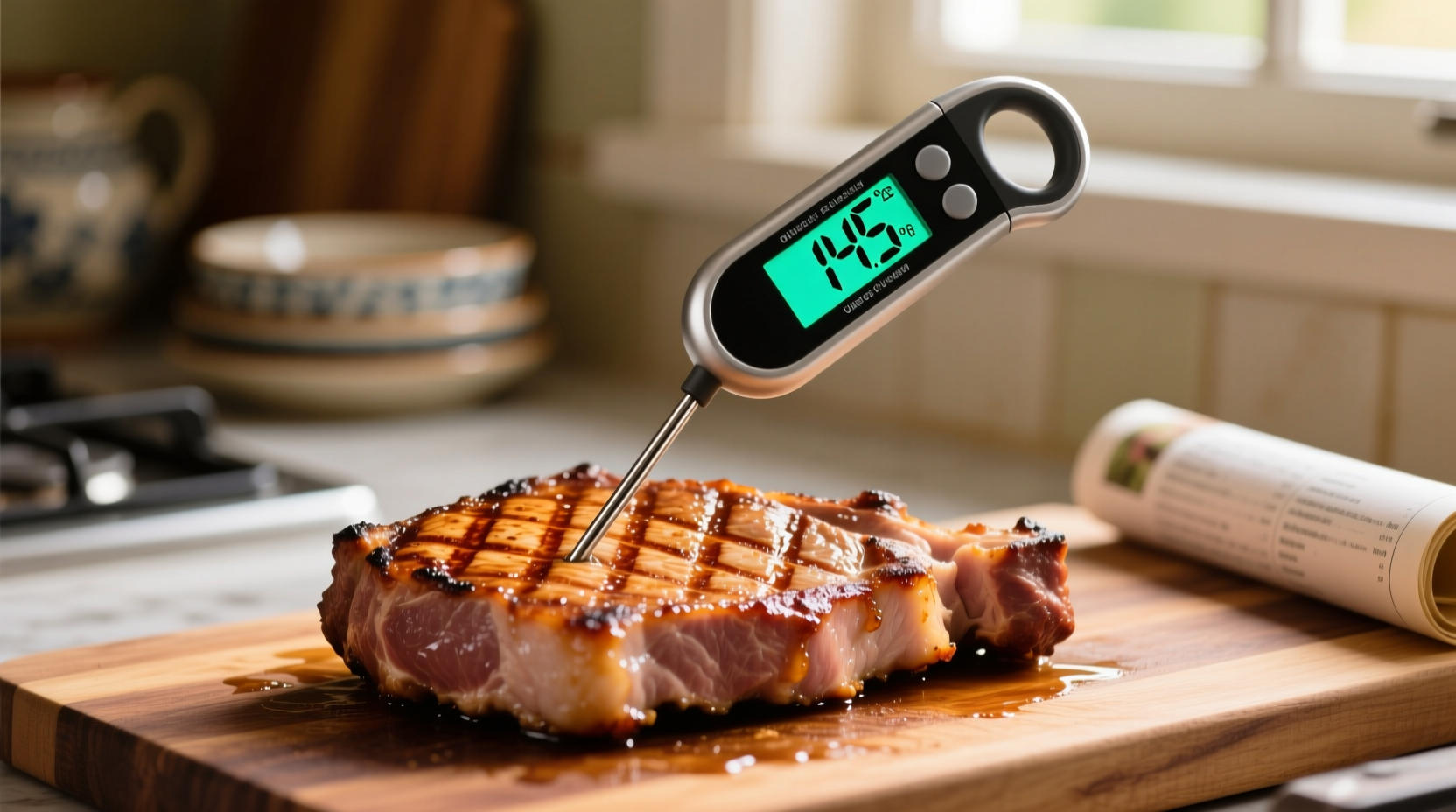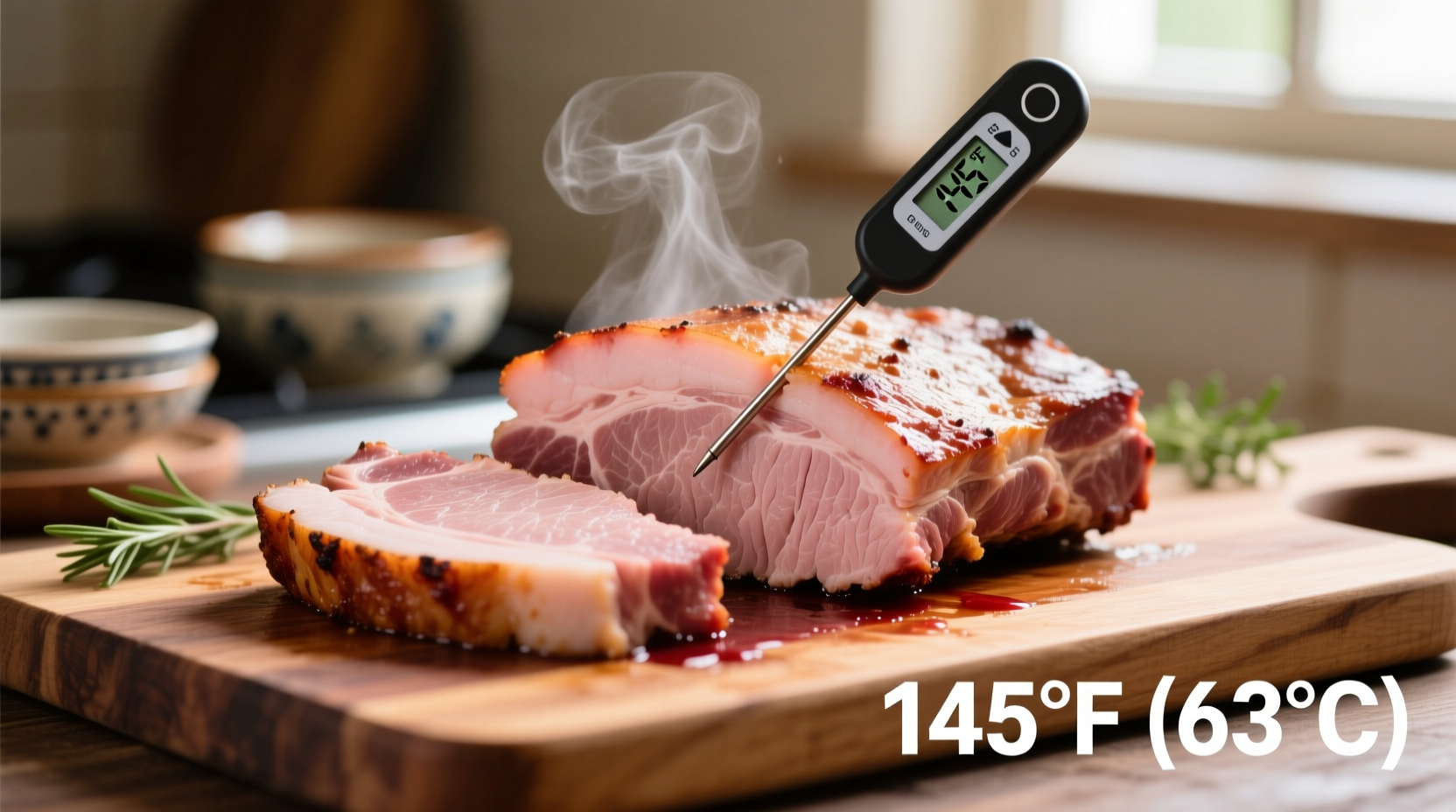The safe minimum internal temperature for cooking whole cuts of pork is 145°F (63°C) with a 3-minute rest period, according to the USDA Food Safety and Inspection Service. Ground pork should reach 160°F (71°C) for safety.
Confused about pork cooking temperatures? You're not alone. Many home cooks still follow outdated advice that leads to overcooked, dry pork. Modern food safety science has updated recommendations, allowing you to enjoy juicy, perfectly cooked pork while staying safe. Let's explore exactly what temperature pork should reach for optimal safety and quality.
Why Pork Temperature Matters: Beyond Just Safety
Proper pork cooking temperature serves two critical purposes: eliminating harmful pathogens and delivering the best eating experience. The USDA's updated guidelines reflect significant advancements in food safety research. Trichinella spiralis, the parasite traditionally associated with undercooked pork, has become extremely rare in commercial pork production due to improved feeding practices and regulations.
| Pork Cut Type | Safe Minimum Internal Temperature | Rest Time | Visual Doneness Indicator |
|---|---|---|---|
| Whole cuts (chops, roasts, tenderloin) | 145°F (63°C) | 3 minutes | Slightly pink center, clear juices |
| Ground pork | 160°F (71°C) | None required | No pink color remaining |
| Pork ribs | 145°F (63°C) | 3 minutes | Meat pulls back from bones |
| Pre-cooked ham | 140°F (60°C) | None required | Ready to eat |
The Evolution of Pork Cooking Guidelines
Understanding the timeline of pork temperature recommendations helps explain why many people still cook pork to higher temperatures than necessary:
- Pre-2011: USDA recommended cooking pork to 160°F (71°C), resulting in well-done, often dry meat
- May 2011: USDA updated guidelines to 145°F (63°C) with 3-minute rest for whole muscle cuts
- 2013: FDA Food Code adopted the same temperature standard
- Present: 145°F remains the official recommendation, supported by extensive food safety research
This change wasn't arbitrary. According to the USDA Food Safety and Inspection Service, the combination of 145°F internal temperature plus a 3-minute rest time provides equivalent safety to the previous 160°F recommendation because pathogens continue to die during the resting period.
Using a Meat Thermometer Correctly: Your Essential Tool
Visual cues alone can't reliably determine pork doneness. A food thermometer is the only accurate way to verify proper cooking temperature. Here's how to use one effectively:
- Insert the thermometer into the thickest part of the meat, avoiding bone, fat, or gristle
- For thin cuts like chops, insert sideways through the side
- Check temperature toward the end of cooking time
- Remove pork from heat source when it reaches 140-142°F (60-61°C) - it will continue rising during rest
- Allow whole cuts to rest for 3 minutes before serving

Common Misconceptions About Pork Cooking Temperatures
Several persistent myths continue to affect how people cook pork:
- "Pork must be cooked until no pink remains" - The USDA explicitly states that pork cooked to 145°F may still appear slightly pink, which is perfectly safe
- "All pork cuts require the same temperature" - Whole cuts and ground pork have different safety requirements
- "Resting time doesn't matter for safety" - The 3-minute rest is an integral part of the safety equation
- "Older guidelines were safer" - Modern guidelines are based on more sophisticated food safety science
Special Considerations for Different Pork Cuts
While the 145°F standard applies to most whole-muscle pork cuts, some preparations require special attention:
- Pork shoulder for pulled pork: Needs to reach 195-205°F (90-96°C) to break down connective tissue, but safety is achieved well before this temperature
- Pork belly for crispy skin: Requires higher temperatures (225-250°F/107-121°C) for rendering fat, but internal temperature still only needs to reach 145°F for safety
- Cured pork products: Pre-cooked hams only need to be reheated to 140°F (60°C)
What Happens If You Don't Reach Proper Temperature?
Consuming undercooked pork carries potential risks, though modern commercial pork is significantly safer than in previous decades. According to the Centers for Disease Control and Prevention, trichinellosis (formerly called trichinosis) is caused by eating raw or undercooked meat from animals infected with the larvae of a species of worm called Trichinella. While rare in the United States (with an average of 16 cases reported annually between 2011-2015), it's still a preventable risk.
Practical Tips for Perfect Pork Every Time
Follow these professional techniques to achieve restaurant-quality results at home:
- Bring pork to room temperature before cooking for more even heating
- Use an instant-read thermometer for precise temperature monitoring
- Don't skip the rest period - this allows juices to redistribute
- For thicker cuts, consider reverse searing: cook low and slow first, then finish with high heat
- When in doubt, check temperature in multiple spots as heat distribution can be uneven
Temperature Verification: More Than Just Safety
Proper temperature control affects more than just safety - it dramatically impacts eating quality. Cooking pork to 145°F rather than the outdated 160°F standard preserves moisture and tenderness. Research from the American Meat Science Association shows that each 5°F increase in cooking temperature beyond 140°F can result in up to 10% more moisture loss in pork.
When to Be Extra Cautious
While the standard guidelines apply to most situations, certain circumstances warrant extra precautions:
- Immunocompromised individuals: Consider cooking to 150°F for added safety margin
- Wild game pork: Wild boar should be cooked to 160°F due to higher trichinella risk
- Leftovers: Reheat to 165°F (74°C) for safety
- Slow cooking: Ensure pork reaches 145°F within 2 hours to avoid bacterial growth in the danger zone
Final Thoughts on Pork Cooking Temperatures
Modern food safety science has given us the gift of perfectly cooked, juicy pork that's still completely safe to eat. By following the current USDA recommendation of 145°F with a 3-minute rest for whole cuts, you can enjoy pork that's both safe and delicious. Remember that a reliable meat thermometer is your most important kitchen tool for achieving this balance. When you understand the why behind the temperature guidelines, you can cook pork with confidence and enjoy results that might surprise you with their tenderness and flavor.











 浙公网安备
33010002000092号
浙公网安备
33010002000092号 浙B2-20120091-4
浙B2-20120091-4